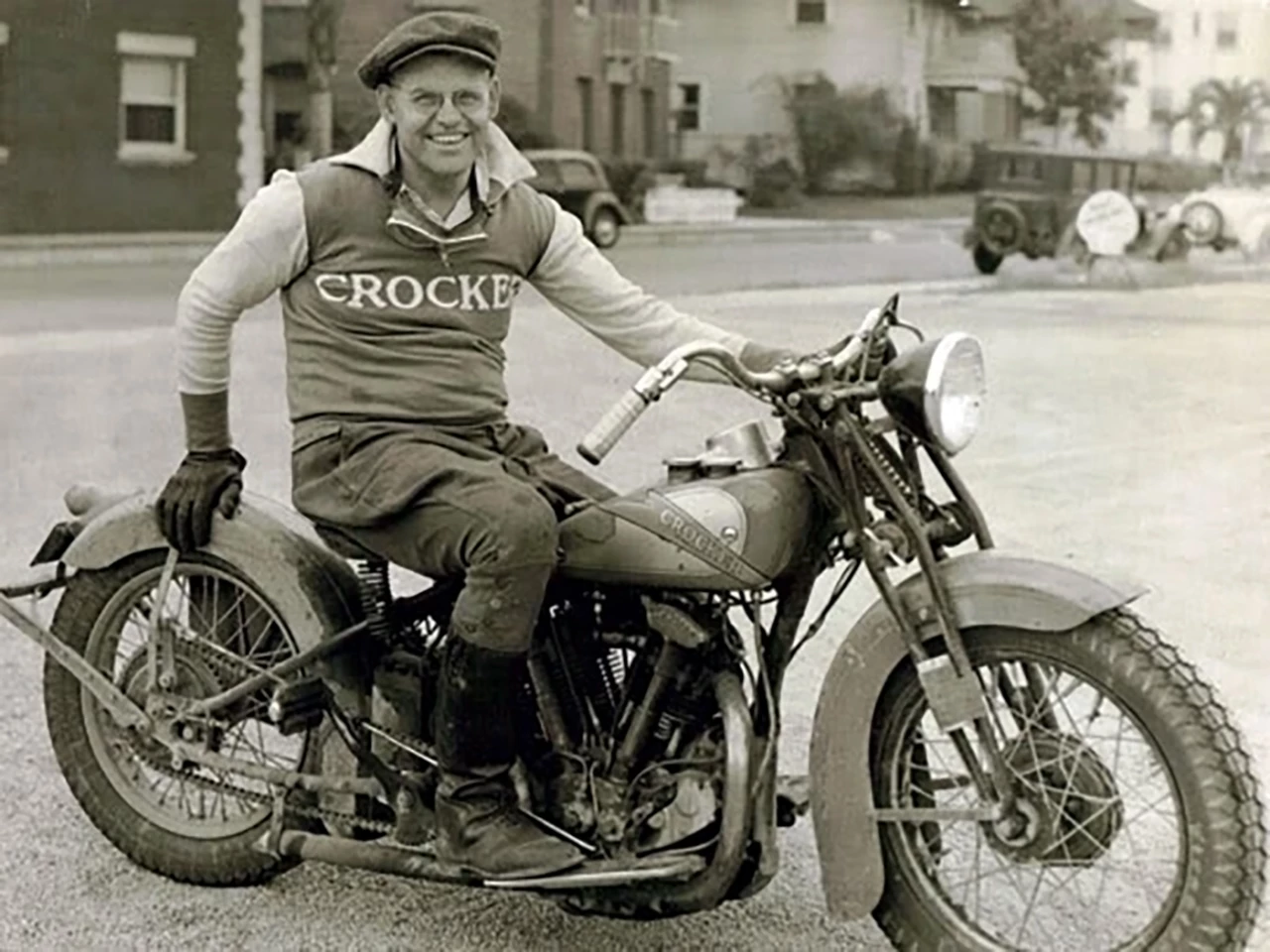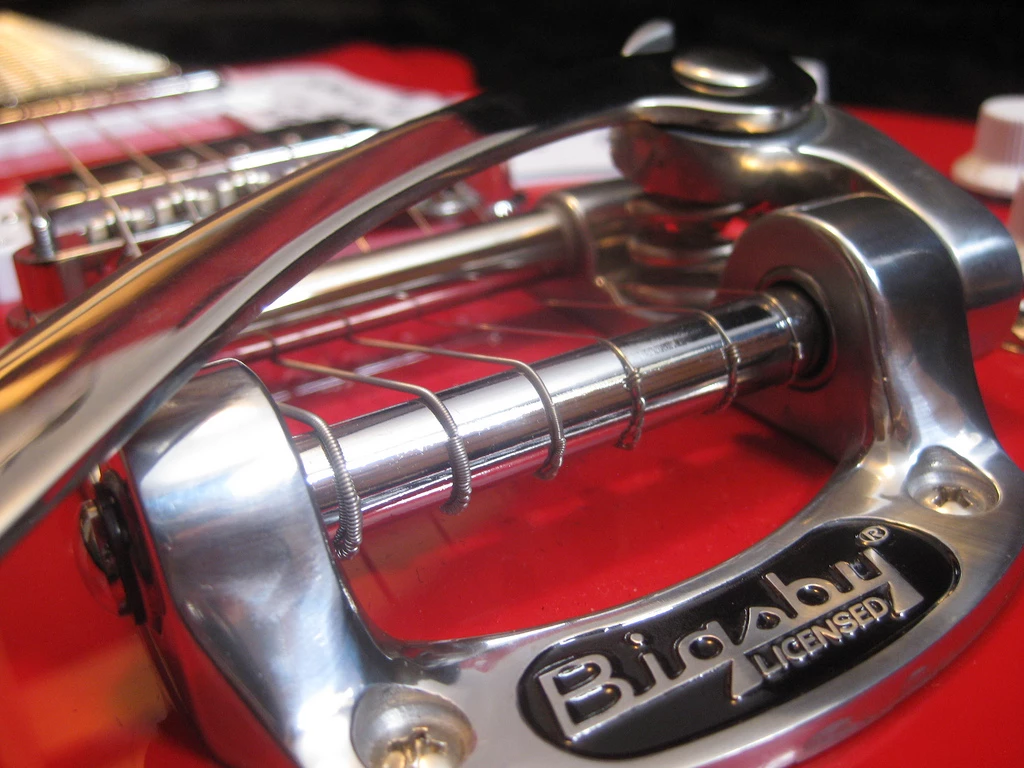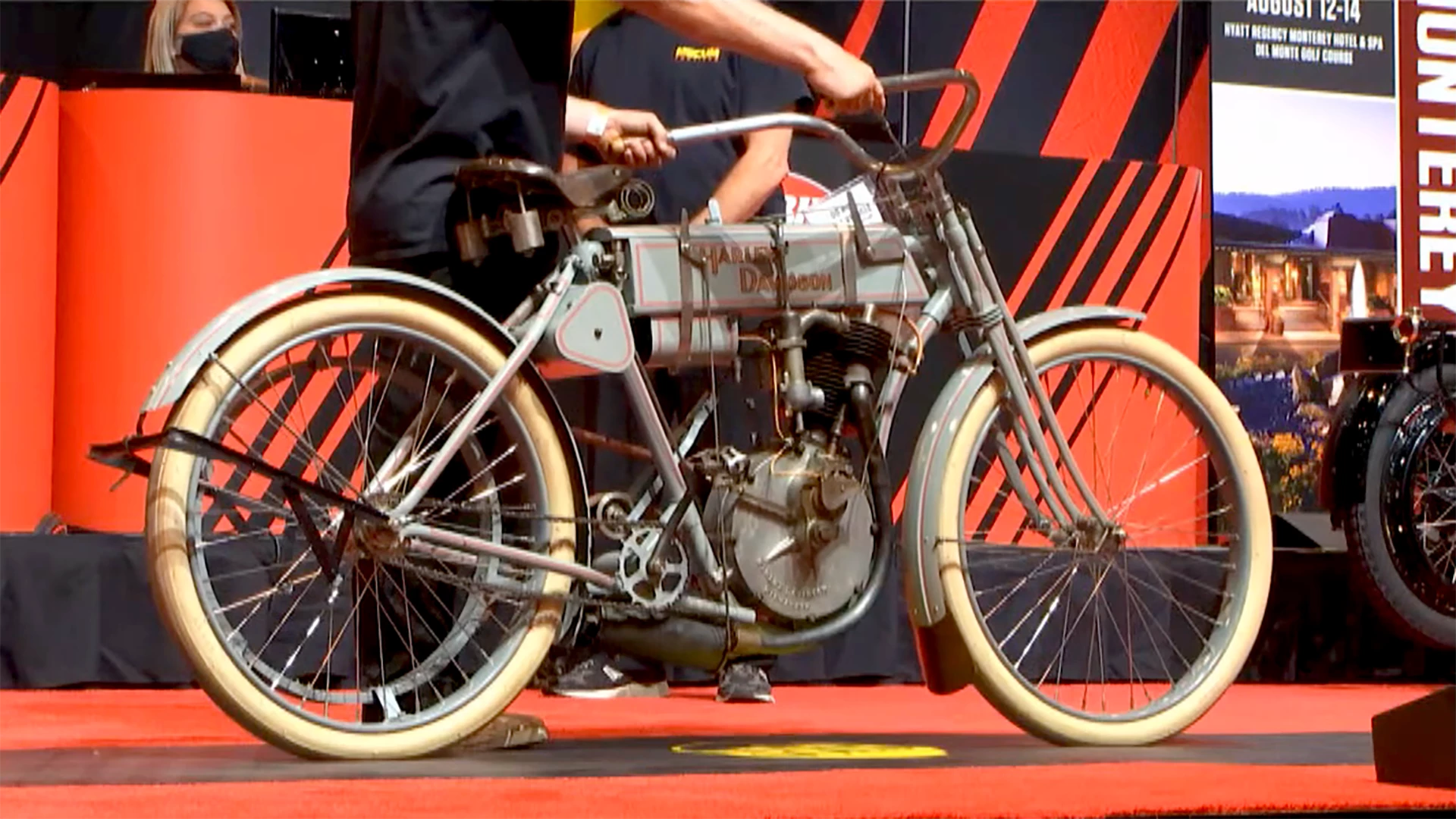We’ve been waiting a long time for the first million dollar motorcycle, and in a world heavyweight contest of sorts, three American-made motorcycles capable of breaking that barrier will all go to auction within a few minutes of each other (lots 684, 701 & 727) on the same stage on the final day of Mecum's annual Las Vegas Motorcycle Sale.
Mecum’s Las Vegas January auction is the biggest motorcycle auction on the planet each year, but it will be bigger than usual this year thanks to the sale of one of the finest collections of motorcycles ever assembled privately. The depth and breadth of the collection and the quality of the finest examples of the most important motorcycles in it is beyond museum quality and it is a shame in many ways that the collection cannot be sold as one.
In a perfect demonstration of what synergy means, the integrity of this collection has yielded a whole that is greater than the sum of its parts, as it includes just about every significant American motorcycle ever built.
It's missing a Curtis v-twin and little else by my reckoning. We'll be doing an in-depth preview of the auction in the next few weeks, as it contains some of the nicest examples of iconic designs that you will ever see in one place. While we may not see a million dollar motorcycle, we will definitely see a raft of world records – marque records for the most valuable example of a particular brand.
If that's not enough to pique your attention, the late and delightfully eccentric Urban S. Hirsch III who collected this museum full of delights is one of nature's more colorful success stories. The private museum in which the Urban S. Hirsch III Collection was formerly housed was an entire wing of Hirsch's palatial residence, across multiple rooms and floors.
Urban grew up poor, hung out as a kid at the LA motorcycle shop of Bud Ekins (famous racer, American ISDT representative, raconteur and, most famously, Steve McQueens stunt double, drinking buddy and oft-time partner-in-late-night-shenanigans), became fabulously wealthy by securing printing ink contracts when newsprint was the medium of the day, but never stopped hanging out with his motorcycle mates.
In his preview of the collection, the Vintagent's Paul D'Orleans wrote thus: Hirsch would often show up at motorcycle events wearing a customized jacket (or jackets, if he brought along one of his many lady friends) with heat-transfer lettering on the back with an obscure (or slyly obscene) pun or double-entendre: “I started out with nothing … and I still got most of it left,” “Medicated … for your protection,” and “We cheat the other guy and pass the savings on to you.”
He sounds like a fascinating fellow who thoroughly deserves a place in motorcycling folklore, because he showed up at a lot of events, including the inaugural Cannonball Run, and rode a lot of miles and celebrated his motorcycling passion like few others have ever had the wherewithal to pursue.
While the quality of the supporting bouts is as good as any we've seen, it's the heavyweight contest for the world crown that tops the bill and it promises one of the most mouth-watering comparisons that chance might ever conjure.
It is a three-way heavyweight contest between the three contenders with a viable chance of breaking the long-standing US$1 million barrier.
Here's the top 10 motorcycles to have sold at auction, with prior sales of the three bikes color-coded.

The three headline acts at the auction are a 1915 Cyclone V-Twin, an original first model 1908 Harley-Davidson ‘Strap Tank’, and a 1938 Crocker V-twin.
As you can see from the lead graphic, those three models already make up eight of the 10 most valuable motorcycles ever sold at auction. By February 2, that number will be nine of 10, and the Rolls Royce of motorcycles will be missing from the top 10 list for the first time ever.

1915 Cyclone V-Twin
The eye-candy presentation of the Cyclone belies what a beast it is.
Cyclone's history encapsulates the ethos of "live fast, die young, leave a good-looking corpse." For those who don't know the back story, the pretty colors might get in the way of accurately perceiving this bike.
It was a world-beater in its day, but the sport in which it competed is now dead, and highly unlikely to ever be resurrected, because it was ridiculously dangerous for everyone, including the spectators.

Different sub-sets of the population view items differently at auction, and the grouping of people who are prepared to own an $800,000 mechanical artwork are all part-historian and recognize the roots of America's unique motorcycle culture.

Board track racing was the beginning of that culture and in terms of motorsport, think of board track racing as the missing link to the original Roman chariot races which pioneered wheeled sport.
Just as chariot races originated as a spectator sport alongside humans fighting to the death with other humans and wild animals, there was an initial cavalier disregard of anything as unmanly as safety when it came to the racing. Ditto for board track racing.

Circuits were built near the center of major cities across America at the turn of the century, long before safety concerns became paramount in public thought, and with the attraction of having an event that that could be heard 10 miles away, they became spectator magnets and a lot of money was made in the first decades of the 20th Century.
The MotorDome was a perfectly circular banked one mile circuit (bottom right in the above image) located in Playa Del Ray under the flight path of LAX – it burned down in 1913.
The image at bottom left sees the timber for one of these vast constructions being hauled in by horse and cart, indicating just how long ago this time was in the history of motorized transportation.
Motor racing did not involve any form of noise mitigation at that time, and one can only imagine what a field of 1000cc v-twins with open pipes must have sounded like 120 years ago as they went past at 110 mph.
In little more than a decade, as understanding grew of the science of these new machines, the rudimentary single cylinder 500cc internal combustion engine that began proceedings rapidly developed to where it was producing ridiculous speeds, and the subsequent 1000cc v-twins (which have given American motorcycling its own distinctive staccato sound track) quickly exceeded 100+ mph average speeds and the bikes outgrew the circuits, people got hurt and it all got stopped on safety grounds.
In its day, the Cyclone was clearly faster than anything else over a short board track course, but it proved too fragile to take out to any of the championship events, which tended to be longer races.
The engineering ideas were sound – the metallurgy wasn't there to support it at that time. Although it was one of 120 American motorcycle manufacturers at that time, its profound short race speed made it a crowd favorite and it somehow managed to stand out from a big crowd despite producing very few actual road bikes. At a time when the phrase "win on Sunday, sell on Monday" was coined, failing to finish races was not good advertising.
Competition at national level requires a development budget, which narrows the long-term competitors to those producing successful road bikes, and the few Cyclone road bikes that exist have been so closely held that we aren't aware of one ever being offered for public sale previously.

This is such a bike. This is the road-going version of the insanely fast Board track racer, even though you might struggle to recognize it as a road bike because it doesn't have any lights.
That's because electric lights were a new invention at that time, with the first vehicular electric light shown in 1898, the first carbon-based headlamp bulb capable of running off a battery produced in 1908 and the initial difficulties of waterproofing best illustrated by Cadillac's 1912 pronouncement that it had invented an advanced electric headlamp that could be operated risk-free when it was raining. Predictably, it took decades for lighting requirements to become standardized.
While it may not have lights, it isn't entirely spartan, as it has a silencer of sorts, and most importantly, it is blessed with suspension at both ends. With roads as they were at this time, a 120 mph road bike with the rigid frame and forks of the Board Tracker would have been a bone-jarring experience capable of shaking teeth fillings loose.
Hence, while we are referring to this bike as an in-period roadster, if you wanted to ride it on the road these days, you'd need to be a close relative of the police chief.
It is a road bike of the day however, and it is indicative of what you bought if you were a sportingly-inclined individual in a hurry 120 years ago at the very beginnings of powered personal transportation.
This was the Ducati Desmosedici of its day, AND you could ride it on the road. This would most likely have been the fastest road-going motorcycle on the planet at that time, with the racing version almost identical and timed at 121 mph.
Just the fact this is a roadster and not a race bike puts it into unprecedented auction territory and rarity drives price. One of the elite group of Cyclone owners pictured above might decide they want a matching set of racer and roadster, so ... anything might happen.

The Cyclone is the most likely of the three bikes to finish this auction on top of the list, if for no other reason than it is extremely rare and has twice previously been the most valuable motorcycle ever sold at auction.

1938 Crocker V-twin
The second most likely marque to take the auction crown and crack the million, is the Crocker.
Crocker only made two basic models in its short existence, with a very competitive speedway bike the lesser known and less valuable of the two. It also made OHV conversions for Harley owners, which are also highly coveted.
It was the company's OHV V-twin that is now the most coveted road bike on the planet, and apart from the four Crockers in the top 10, we think we can track all the Crocker V-twins that have sold this century, with the others having sold for $423,500, $385,000, $371,800, $302,500, $302,000, $302,000, $291,000, $276,500, $243,800, $236,500 and $233,200. That's all that we've ever seen at public auction apart from the occasional Crocker speedway bike, and the lowest price a Crocker has sold for in living memory is a cool quarter million. A highest price can be an outlier, but a high lowest price indicates an insatiable demand.
Since that time, the big Crocker has been climbing rapidly in value and is now in the unattainable category for most, but the virtues it embodies are worth remembering – it’s still a viable, comfortable and fast motorcycle to go riding on, belying its octogenarian vintage.
Logic would suggest that none of the bikes in contention for the heavyweight crown will ever get used again, as they are far too valuable to ride and depreciate far quicker than cars if they are used on public roads.
But if the sun comes up one morning to a glorious day and you have a set of twisties nearby, there aren't many blue chip investments you can repurpose for an hour or five ... and a bit of patina always validates a motorcycle IMHO.
The competence and confidence and sheer chutzpah of the small Crocker concern is captured in one of the company's advertising pledges: Crocker offered a "money back guarantee" if your Crocker was ever beaten in a race with a Harley-Davidson. No-one ever made the claim.
The all-powerful Harley-Davidson survived the war, but Crocker didn't and as history subsequently showed, the Crocker name was built on the genius of more than one person.

There’s also a distinct rock-n-roll element to the Crocker brand values, because as revered as Albert Crocker is to America’s motorcycling heritage, Albert Crocker’s “foreman” was Paul Bigsby who went on to build the first electric guitar, the Bigsby vibrato tail piece and his role in popular music is so great that his contribution to Crocker rates barely a mention in his Wikipedia profile.

Bigsby vibratos are still factory-installed on many of today's electric guitars from quality brands such as Epiphone, Fender, Gibson, Gretsch, and Ibanez, but it's the top 100 most valuable guitars ever sold at auction where you'll see a complete domination of the popular music genre by Crocker's Number Two Paul Bigsby. Every name guitar player since the electric guitar began, from the Beatles down, used his invention. Many of the Guitar Gods preferred the sounds of different guitars, but they all used a Bigsby!
So although it's a landmark bike and an exquisite design, I'm tipping that Bigsby's involvement is going to keep this brand relevant and current long into the future.
As Bigsby's contribution to the sound of modern music is fully realized as one of those larger-than-life characters who influence cultural history across several genres, Paul Bigsby's name will become ever more prominent and recognizable. Bigsby would have labored many hours on every single bike that left the small Crocker motorcycle factory. I've always noticed a high correlation between motorcycle riding and musicians, so perhaps that might count too!
Records are so sparse that no-one is sure how many Crockers were made, but demand so far outstrips supply that we can't see them ever declining in value over time. The Crocker is the closest of this three-bike shoot-out to motorcycles as we expect them to be today.

1908 Harley-Davidson ‘Strap Tank’
The Harley-Davidson “Strap tank” is the first Harley-Davidson model produced, beginning with a 440cc version. Just how much of a motorcycle needs to be authentic for the entire bike to be authentic is a debatable point, but rarity is pushing that percentage downwards and the Harley-Davidson brand has values that are timeless and difficult to quantify.
We’re regarding this bike as somewhat of a sleeper, because prices will sometimes jump inexplicably when the tank emblem reads H-D, as was the case with the bike that currently holds the $935,000 world record.
In 2016, the same bike went to the Mecum January Las Vegas auction and was passed in when bidding stopped at $400,000. Untouched, seven years later, on the same stage, in front of the same audience, it fetched more than twice as much – from unloved to world record holder in one rather puzzling step.
If I can't get there to witness this event, I'll be watching on the internet – I'm tipping history will be made.
Watch for our preview coming soon.












